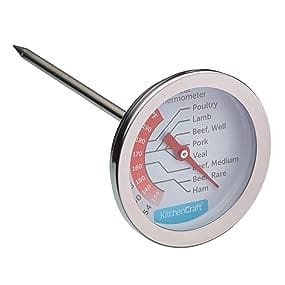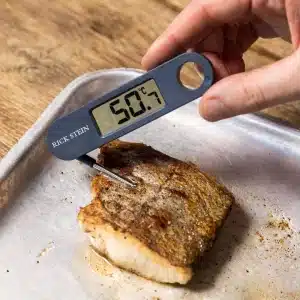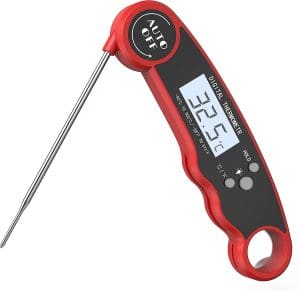Are you looking for a way to cook your meat to perfection every time? Do you want to avoid the risk of undercooking or overcooking your festive feast?
If so, you might want to invest in a meat thermometer, a handy device that can measure the internal temperature of your meat and tell you when it’s done. You might see a recipe for roasting a joint that calls for the cook to ‘look into the meat’ to ensure the meat is cooked. Without carving or drilling a hole into the joint, this can be difficult and also affects the finished dish – that’s why a meat thermometer is worth investing in.
Also, if you aren’t a confident cook, or you are cooking a massive turkey for a house full of guests, then there’s no need to panic about whether the bird is cooked – a simple thermometer will tell you.
Here, the Christmas.co.uk team takes a closer look at what is on offer – and how to choose a meat thermometer for your needs.
What is a meat thermometer and how does it work?

The digital versions come with a display that shows the temperature of the meat in degrees Celsius or Fahrenheit.
Some models also have an alarm that goes off when the meat reaches a certain temperature, or a wireless connection that lets you monitor the temperature from your smartphone. These are very expensive, and most people simply won’t need that many functions.
There are also (much) cheaper analogue versions that work by pushing the probe into the meat and the arrow will flip around to the current temperature – they usually have a chart showing the type of meat and what level of being cooked it is, from rare to well done beef, for example. It might be simple to use and old-fashioned for some people, but it gets the job done.
Also, some thermometers are designed to remain in the meat for a quick check of its temperature without having to remove from the oven first.
Why is a meat thermometer a good investment?
While meat thermometers are available at various price points – from £6 to £120+ – a basic one will meet most peoples’ needs. It will help you achieve several benefits, such as:
- Ensuring food safety: Cooking meat to the right temperature can kill harmful bacteria that may cause food poisoning, such as salmonella or E. coli. Different types of meat have different safe minimum temperatures, which you can check on the Food Standards Agency website
- Improving taste and texture: Cooking meat to the right temperature can also enhance its flavour and juiciness, as well as prevent it from becoming dry or tough. For example, different cuts – particularly cuts that require slower cooking to make them delicious, such as brisket, really do benefit from using a meat thermometer. We think also they are worth using when roasting a beef joint or cooking a steak where the request is from rare to well done – a thermometer helps to remove the guesswork that many cooks will use to deliver perfection!
- Saving time and money: Using a meat thermometer can help you avoid wasting time and energy by constantly opening the oven door or cutting into the meat to check whether it is cooked. It can also help you avoid wasting money by throwing away overcooked or undercooked meat.
Why should you use a meat thermometer at Christmas?

A meat thermometer can take away some of the stress and uncertainty by letting you know exactly when your meat is ready to serve. Afterall, you have spent time and money to enjoy the dish so it’s worth ensuring that you dish up the meat at the correct temperature!
It can also help you avoid disappointing your guests or ruining your festive mood by serving them dry, bland or unsafe meat. Even if you are cooking rare steak, a meat thermometer could be an invaluable way to deliver a memorable meal.
Which type of meat thermometer should you buy?
If you’re looking for simplicity in temperature monitoring without the need to repeatedly check and reinsert it into the oven, in-oven thermometers could be the right choice.
However, they require a functional oven light or the opening of the oven door to read.
Analogue models, while bulkier, might not be suitable for smaller meat portions like chicken thighs. That’s because the probes tend to be longer than digital ones and need to be pressed further into the meat. Also, these thermometers typically necessitate an operational oven light for reading or involve opening the oven door.
Probe thermometers, on the other hand, come with an insertable probe that remains connected to the unit through heat-resistant wiring. Often magnetically attachable to the oven, they allow easy temperature checks without interference. These devices display real-time meat temperature and emit a beep when readiness is reached.
However, if your oven is frequently opened for tasks like basting or adding different dishes, these thermometers could be cumbersome.
Also, there are some probe thermometers which support multiple probes – useful if you’re cooking and want to monitor more than one dish as it cooks. These thermometers also tend to have a separate probe for general oven temperature – which is useful as the temperature dial on the oven may be a long way from the expected temperature. This could be a great investment if yours is an older oven, for example, and may not be running at the temperature you are needing for your festive roast!
For swift readings, instant-read thermometers are a solid option.
Available in both analogue and digital versions, they require inserting the thermometer after removing the meat from the oven.
Some models solely provide temperature information, while others display recommended temperatures for various meats – so you can quickly check whether your meat is ‘done’.
Most of these thermometers show temperatures in both Celsius and Fahrenheit or offer a convenient switch between the two.
If you’re interested in cutting-edge technology, thermometers with accompanying apps might be appealing.
These probes are placed in the oven and connected to a downloadable app on your phone.
Through the app, you can set your desired temperature and receive alerts accordingly.
Tips on using a digital thermometer

Incorrect positioning — whether too shallow or excessively deep — will yield an inaccurate reading, representing the outer rather than the inner temperature.
For meats still attached to bones, like beef ribs or lamb legs, ensure the thermometer’s tip doesn’t touch the bone’s surface to avoid gauging bone temperature.
When preparing meats on a barbecue or in a pan, measure the temperature away from the cooking surface.
This prevents the influence of residual heat from the hot pan or grill.
In the case of whole birds such as chickens and turkeys, the most precise temperature reading is obtained by probing the thickest part of the thigh, within the space between the thigh and the breast – but avoid contact with a bone.
Once you’ve selected your probing point, exercise patience and wait for temperature fluctuations to cease before noting the final reading.
It’s important to note, especially when dealing with large meat cuts or entire birds, that the temperature will rise by approximately 5°C during resting.
Christmas.co.uk Top Tip: Essentially, you will have a target temperature in mind at which point you will remove the meat from the oven. You should also check again the meat’s temperature after resting. For poultry, this check is really for moistness and safety considerations. For beef, the temperature readings will have an impact on the look of the meat from rare to dry. We should also highlight that you can continue to probe while resting the meat so you will ensure that the beef doesn’t overcook from what is known as ‘carry over cooking’.
This issue for cooking beef to the correct temperature and finished look also means not lowering the temperature for the cooking time to achieve a ‘rare’ look, for instance. Instead, you should plan to slightly reduce the time in the oven since the beef continues cooking – but as you have a thermometer you can double check and don’t just need to rely on timings to determine if something is ready or not. This could be a crucial tool when hungry guests are waiting!
Using a meat thermometer for the first time
To use a meat thermometer correctly, follow these steps:
- Before using it for the first time, read the instructions carefully and calibrate it if needed
- Before inserting it into the meat, make sure it is clean and dry
- Insert it into the thickest part of the meat – make sure it reaches the centre of the meat without poking out from the other side
- Wait for the temperature to stabilise and read it on the display. Compare it with the recommended temperature for your type of meat and cooked preference
- If the temperature is lower than desired, continue cooking and check again later. If the temperature is higher than desired, remove the meat from the heat source and let it rest for a few minutes before serving
- After using your meat thermometer, clean it with hot water and soap or an antibacterial wipe. Store it in a safe place until next use.





